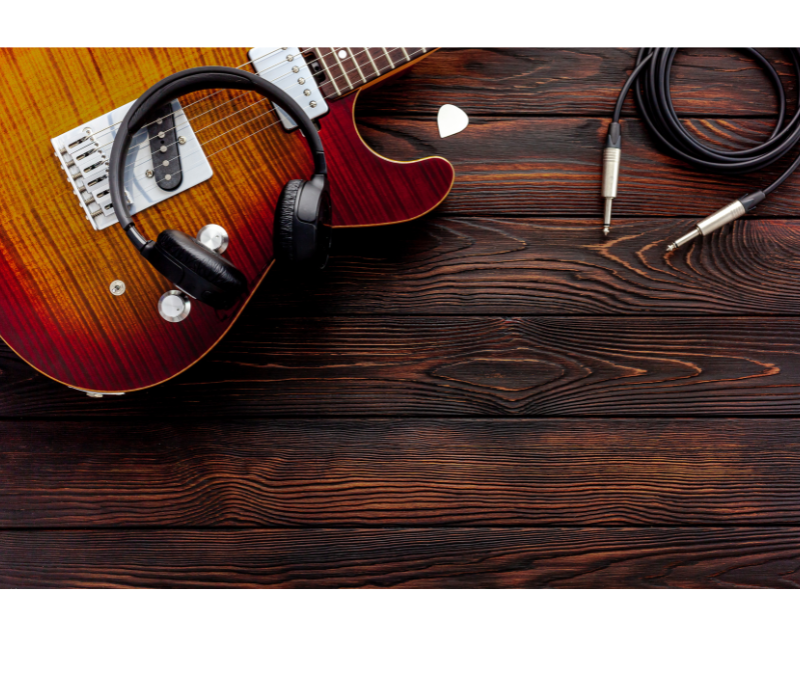Are you an aspiring guitarist looking to plug in and rock out on the electric guitar? Whether you’re drawn to the blistering solos of rock legends or the smooth melodies of jazz masters, the electric guitar offers endless possibilities for creativity. But where do you begin your journey on this iconic instrument? Here are six techniques to learn electric guitar for beginners.
1. Power Chords: The Foundation of Rock
Let’s kick things off with power chords, the backbone of rock music. Power chords are simple yet powerful, consisting of just two or three notes played together. Start by placing your index finger on the root note of the chord (typically the lowest string), then add your ring finger or pinky on the next string two frets higher. Experiment with different combinations and positions to create that classic rock sound. Power chords are a great way to master the electric guitar for beginners.
Practice Tip: Work on transitioning between different power chords smoothly. Start with basic progressions like E5, A5, and D5, then gradually incorporate more complex chord changes.
2. Palm Muting: Adding Texture and Dynamics
Palm muting is a technique that involves lightly resting the edge of your picking hand on the strings near the bridge while you play. This creates a muted, percussive sound that adds depth and dynamics to your playing. Experiment with varying degrees of pressure and placement to find the perfect balance between clarity and heaviness.
Practice Tip: Practice palm muting with a metronome to develop a steady rhythm. Start slow and gradually increase the tempo as you become more comfortable with the technique.
3. Bending: Infusing Your Playing with Emotion
One of the most expressive techniques in guitar playing is bending, which involves pushing or pulling a string across the fretboard to raise its pitch. Mastering bends adds soul and emotion to your solos, allowing you to mimic the vocal-like qualities of your favorite guitar heroes.
Practice Tip: Start with half-step bends (one fret) and gradually work your way up to full-step bends (two frets). Focus on bending with control and accuracy, using your ear to gauge the pitch.
4. Scales: Building Your Musical Vocabulary
Learning scales is essential for understanding the language of music and improvisation. Begin with the minor pentatonic scale, a useful scale used in countless rock, blues, and jazz songs. Practice playing the scale up and down the neck, focusing on clean articulation and consistent finger placement.
Practice Tip: Use backing tracks or jam along with your favorite songs to practice soloing in different keys and musical contexts. Don’t be afraid to experiment and explore new sounds within the scale. If you need help with pentatonic scales we have a tool called the FretDeck that will guide you through each scale in every key.
5. Arpeggios: Unleashing Your Inner Virtuoso
Arpeggios are broken chords played one note at a time, creating a cascading, harp-like effect. While they may seem daunting at first, mastering arpeggios opens up a world of melodic possibilities and adds flair to your solos. Start with simple major and minor arpeggios, then gradually incorporate more complex shapes and patterns.
Practice Tip: Practice arpeggios slowly and evenly, focusing on synchronization between your picking hand and fretting hand. Gradually increase the tempo as you build speed and accuracy.
6. Vibrato: Adding Character and Flavor
Last but not least, vibrato is a subtle yet powerful technique that adds character and expression to your notes. To achieve vibrato, gently oscillate your fretting hand back and forth while holding a note, creating a subtle pitch variation. Experiment with different speeds and widths of vibrato to find your signature sound.
Practice Tip: Start by practicing vibrato on sustained notes, gradually increasing the intensity and duration of the vibrato motion. Listen to recordings of your favorite guitarists to study their vibrato technique and incorporate elements into your own playing.
Inspirational Stories from Guitarists
Every guitarist, no matter how accomplished, started as a beginner facing the same challenges and hurdles. Take inspiration from modern-day guitarists who have overcome obstacles and honed their craft through dedication and perseverance.
As a young Stevie Ray Vaughan embarked on his journey to master the guitar, he faced numerous challenges and setbacks along the way. Born and raised in Texas, Vaughan was deeply influenced by the blues from an early age, but his path to becoming a guitar legend was far from easy. Despite struggling with dyslexia and other learning disabilities, Vaughan poured his heart and soul into his music, practicing for hours on end and immersing himself in the rich tapestry of the blues tradition. Determined to overcome any obstacle in his path, Vaughan’s relentless pursuit of excellence ultimately propelled him to stardom, inspiring countless aspiring musicians with his electrifying performances and timeless recordings. His story serves as a powerful reminder that with passion, perseverance, and a steadfast belief in oneself, anything is possible.
These stories serve as a reminder that greatness is within reach for those who are willing to put in the work and push past their limitations. So pick up your guitar, embrace the journey, and let your passion for music propel you forward on your path to electric guitar mastery.
In conclusion, mastering the electric guitar for beginners is a journey that requires patience, dedication, and a willingness to explore new techniques and styles. By mastering the essential techniques outlined in this guide and drawing inspiration from the stories of modern guitarists, you’ll be well on your way to becoming a confident and proficient electric guitarist.

Download The FretDeck & Chord Secrets Course!
Download Course










